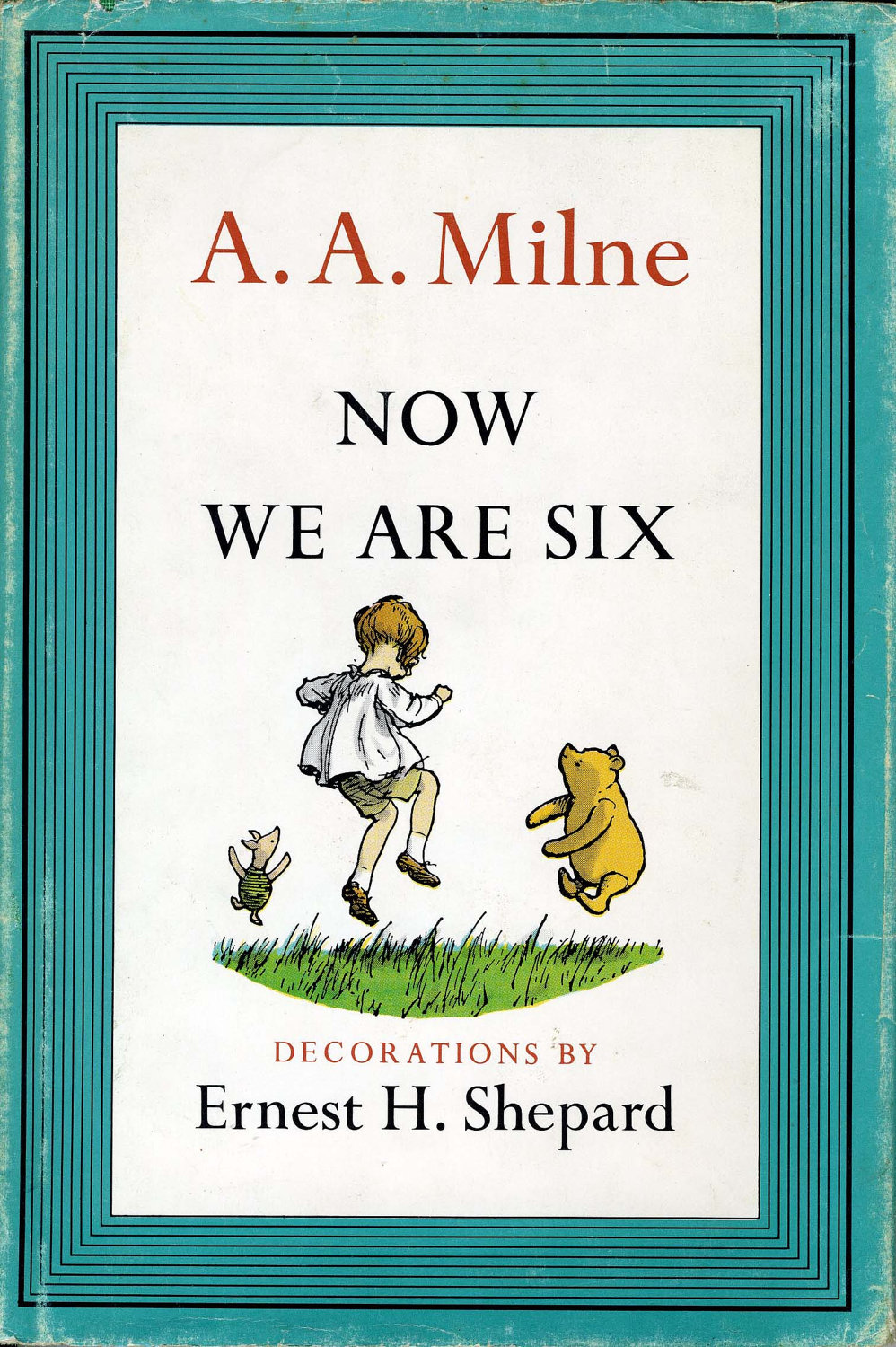
That 80s Pooh: In Which We Examine How Winnie the Pooh’s Popularity Extended from Books and Movies to TV Shows in the 1980s
By Matthew Anscher

One of A.A. Milne's books
2021 marks not only 55th anniversary of Winnie the Pooh as a Disney character but the 95th anniversary of his first appearance in books. While he and his friends only joined the studio’s pantheon of animated characters the same year Walt Disney died, Pooh is only two years older than Mickey Mouse but their respective reputations grew around the same time in different media before the twain finally met. Since then, it’s been hard to imagine Disney without Pooh and his friends. This is especially true if you were a child in the 1980s and 1990s when the characters were arguably at their peak in popularity and exposure on American television. Two shows that came on the heels of the fourth theatrical featurette played no small part in this; one of them was a live-action puppet show, the other a Saturday morning cartoon.
When A.A. Milne first wrote the Winnie-the-Pooh stories in 1926, he could not possibly have conceived how many different types of media his creations would appear in. Nor did he live to see them become Disney characters initially; he had been dead for 10 years when Walt Disney released Winnie the Pooh and the Honey Tree, and Walt himself would be gone less than a year later. The Disneyfication of Pooh was a topic of controversy in the UK, but in the United States, the cartoons proved to be very popular, the second one winning a Best Animated Short Subject Oscar. After four theatrical featurettes, the first three of which were compiled into the feature-length package film The Many Adventures of Winnie the Pooh in 1977, the studio decided to expand that Silly Old Bear’s Fame into yet another medium in the following decade.

Three featurettes were released in 1966, 1968, and 1974 and combined into a feature film in 1977.
Round Every Corner
When The Disney Channel first launched in 1983, one of the first shows they aired was Welcome to Pooh Corner, a half-hour live action show that used life-sized puppets to bring the characters to life. The first episode aired on April 18, 1983 at 8:30 AM ET, and the show aired new episodes five days a week, eventually accumulating 120 episodes. Scripts for 90 episodes were written by Betty G. Birney. It instantly became one of the network’s biggest hits at a time where they were only broadcasting 16 hours of programming a day, but half of it was new material.

The Disney Channel launched on April 18, 1983 with Welcome to Pooh Corner as one of its first shows
Recorded on videotape by Left Coast Television, Inc. in an independent studio off of Santa Monica Boulevard in Hollywood rather than on the Disney lot in Burbank, the show’s specialized style of puppeteering known as Puppetronics was the creation of former Imagineer Ken Forsse, who later became the creator of Teddy Ruxpin. His company, Alchemy II, Inc., built the electronically controlled puppets out of soft foam costumes with electronic receivers that display a wide range of movements, gestures, and expressions when the puppeteers are inside them. One of the puppeteers is a name that should be familiar to Disney fans: Sharon Baird, one of the original Mouseketeers from the Mickey Mouse Club in the 1950s. She performed the Pooh puppet. When it came to creating a puppet for Roo, they just made a conventional one. Even though Roo is a boy, his voice artist was a woman named Kim Christianson, while his puppet was operated by another woman: Patty Maloney, who also operated the Piglet puppet and also played one of Chewbacca’s relatives in the infamous Star Wars Holiday Special in 1978.
When
it came time to cast the voices, Sterling Holloway had retired as the
voice of Winnie the Pooh, so Hal Smith, who was already the voice of
Owl, inherited the role. Paul Winchell was too busy with other projects,
such as Hanna-Barbera’s The Smurfs on NBC where he was the voice
of Gargamel, so the role of Tigger went to Will Ryan, who was
responsible for the 1980 Walt Disney Record Goin’ Quackers about
Donald Duck. His performing partner Phil Baron, who later became a cantor at a synagogue, was
the voice of Piglet.
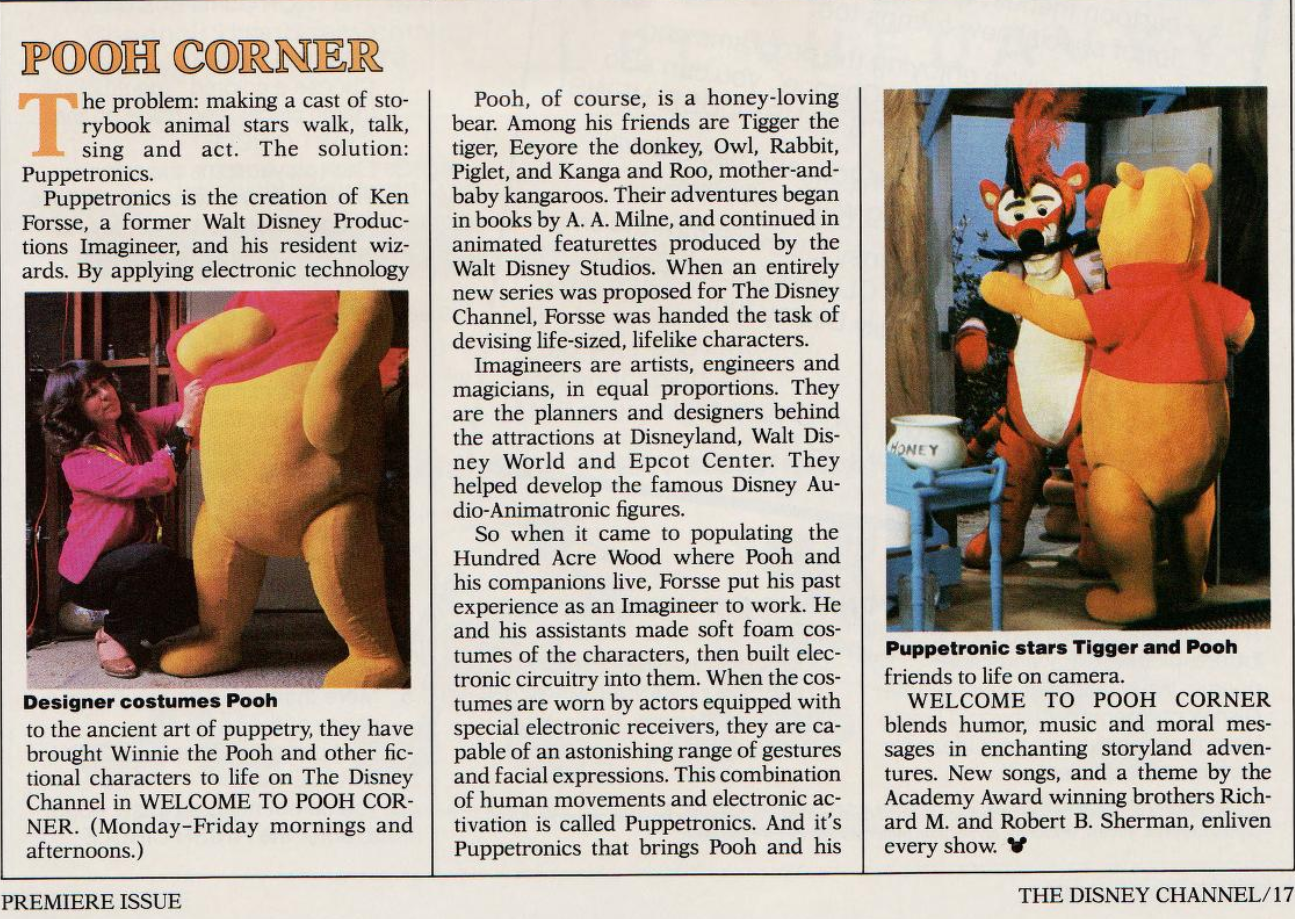
Doing a show with a five-episode-a-week schedule left little room for error, even with ten working hours a day, so they made extensive use of blue screen work via a four-camera video process called Ultimatte. It involved shooting the characters and a few props separately from the backgrounds which would be put in later. The backgrounds included actual animated background cels from the original Pooh cartoons. In truth, this was not the first time the Pooh characters had been turned into puppets. Bil Baird created some marionettes for a Shirley Temple TV show in 1960. But that was just one episode of a show that did many other stories; these puppets were more closely modeled after their animated equivalents.
One
character who wasn’t seen in the show was Christopher Robin, not only
because he would have had to be about 20 feet tall to remain the same
scale as the characters, but according to producer Frank Brandt (who
also produced the Mickey Mouse Disco animated compilation
short from 1979 to tie in with the album of the same name), as quoted in
the Disney News, “[he] was always the problem solver in the
Milne stories; We didn’t want to do that because we think that children
relate to these characters, and we want the children to understand that
maybe you can solve some of the problems yourself.” The only remaining
human character was the Narrator, who was only heard but not seen in the
cartoons. Sebastian Cabot died in 1977 and so the role would have to be
recast. Now, he was both seen and heard and played by Laurie Main, an
Australian-born character actor who asked Rex Harrison “where do I come
from?” in 1964’s My Fair Lady and had already worked for Disney
as a teacher in the original 1976 Freaky Friday with Jodie
Foster. Main also had narrated the most recent theatrical featurette, Winnie
the Pooh and a Day For Eeyore.
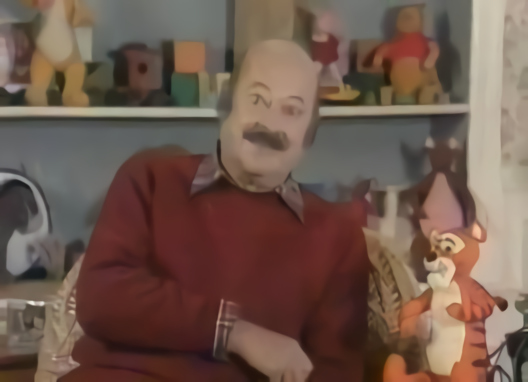
Returning to write songs for the characters for the first time since the 1960s were Richard M. Sherman and Robert B. Sherman, who composed all those memorable songs for the animated featurettes. The “Winnie the Pooh” theme song got new lyrics, while they contributed a handful of songs along with Phil Baron, Will Ryan, Dan Crow, and Robin Frederik. Denise McKenna choreographed the musical numbers. The stories were largely educational in nature and aimed at preschoolers aged 3 to 5, but instead of dealing with letters and numbers the way Sesame Street did, the show dealt with concepts such as self-control (the “Spaghetti” episode) and self-acceptance (the “Piglet Pride” episode). Other episodes had Eeyore losing his tail, Piglet singing to help control his stuttering, and the gang forming a parade. Another one introduced Rabbit’s brother Robert taking Roo on a walk through the Hundred Acre Wood and getting lost. There were even two Christmas episodes and others celebrating Thanksgiving, Valentine’s Day, and Halloween.
The show even took a more serious turn than one would expect for these characters when they appeared in the closest they came to a Very Special Episode: a 40-minute anti-child abuse video called Too Smart For Strangers. Released on video and aired on The Disney Channel in 1985, a time when many shows aimed at children and families felt compelled to address the subject, the special differs from a normal episode in more than just its length; none of the songs are written by the Sherman brothers, while the episode intersperses clips of human children in scenarios where they are in danger of being harmed by adults as Pooh, Piglet, Tigger, Roo, Rabbit, and Eeyore all discuss what they can do to put a stop to this. The Internet made light of it through off-color re-edited versions of the video, but at the time it was taken very seriously as a tool to help fight back against child predators. Many organizations dealing with child welfare gave the program their seal of approval, and the Cable ACE Award-nominated special raised $33,000 for organizations to devoted to stopping child abuse and abduction. One of these organizations was the Adam Walsh Child Resource Center, founded by future America's Most Wanted host John Walsh after his son was kidnapped and killed in Florida in 1981.

The 1985 special received endorsements from celebrities, none of whom actually appeared in it.
There was also an educational film, Winnie the Pooh’s Great School Bus Adventure, in 1986, released to schools by Walt Disney Educational Media Company. Funded by US Insurance Company and Dallas Public Schools, it was shot on tape but kinescoped onto film for schools that still had 16mm projectors, as many did in the days before they invented VCRs. The 13-minute short is unusual because it actually mentions but does not show Christopher Robin, and also because it shows a human puppet in the form of a bus driver. Such Muppet-like puppets were more common on Dumbo's Circus.
The lack of commercials meant the episodes ran almost a full 30 minutes! Reruns continued until 1997 when The Disney Channel started showing commercials and the show’s episodes would have had to be either severely edited or shown in a longer time slot. Walt Disney Home Video released a selection of episodes on VHS and Betamax tape in 1984 and 1985. Its only presence on DVD is through a disc released by the educational department that combines Too Smart for Strangers and Pooh’s Great School Bus Adventure.

In France, where the show was called Les Aventures de Winnie l’ourson and aired on the France 3 television network along with a block of other Disney shows and cartoons, it had a different Narrator, the late actor Jean Rochefort. Unlike the English-language version, Rochefort was featured and credited in the opening of the show. Later in the run, the French version replaced Rochefort with a much younger host, radio presenter Vincent Perrot. The French versions were usually a few minutes shorter than their English-language counterparts. The voice dubbing artists were Jacky Berger, Roger Carol, Claude Chantal, Henri Djanick, and Patrick Prejean. Disneyland Records in France released a 45 of the French version of the opening theme in stereo.
The success of Pooh Corner prompted The Disney Channel to create two more live-action children’s shows based on Disney animated features. The first one was Dumbo’s Circus, based on the classic 1941 animated feature, which premiered in 1985 and used many of the same techniques and technologies as Pooh Corner, The second came a little bit later: Adventures in Wonderland, based on Lewis Carroll’s Alice stories and Walt Disney’s animated 1951 film adaptation, premiered in 1993; shot at Disney-MGM Studios in Orlando, Florida, it used a mix of puppets and live-action actors.
The show has not yet been released to Disney+, leading some people to erroneously assume that this is a “lost” show. But just because they haven’t shown something in a long time doesn’t mean they don’t still possess master tapes; they simply haven’t gotten around to the arduous process of digitally remastering the analog originals yet. It is difficult to believe that Disney would actually actively discard a whole show this late in the game. They still don’t mind filing copyright claims against anyone who releases the episodes to YouTube when they don’t seem to want to do the grunt work themselves.
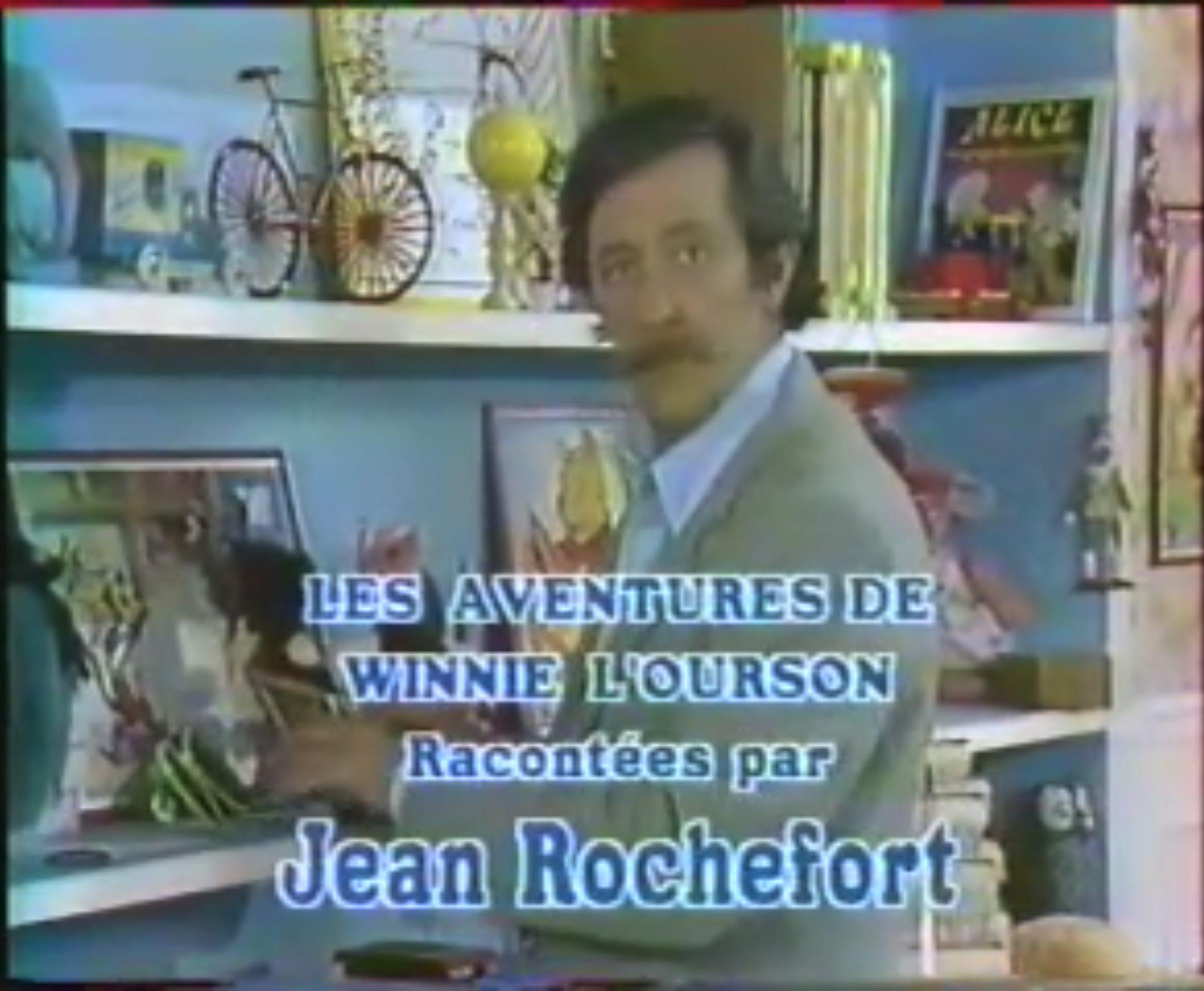
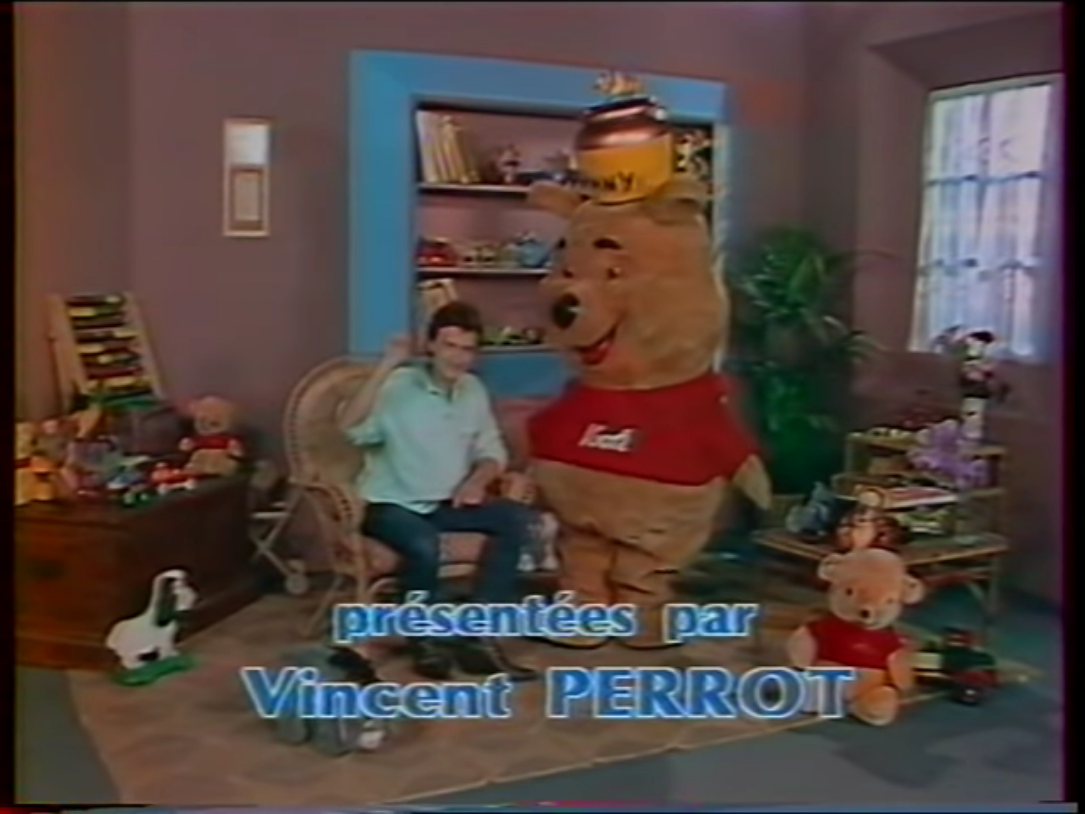
The French-dubbed version of the show replaced Laurie Main's hosting segments as the Narrator with two different men, one much younger than the other.
Saturday Morning Fever
After Pooh Corner had ended production, Disney’s newly formed TV animation unit was looking for ideas for new shows. They had had limited success with newly created characters other than The Gummi Bears, and their next success here was DuckTales, which was based on pre-established characters who had appeared in theatrical animated cartoons and comic books. Based on these, not to mention home video sales of the original four 1966-1983 animated featurettes that rivaled those of the classic animated features, Pooh was a natural choice for their next cartoon. It also didn’t seem to hurt that the company still had an ongoing deal with Sears department stores to put the characters on children’s clothes and toys. ABC was having ratings troubles on Saturday morning, and they wanted a Disney show of their own. They believed the characters would appeal to all ages, not just the youngest viewers.
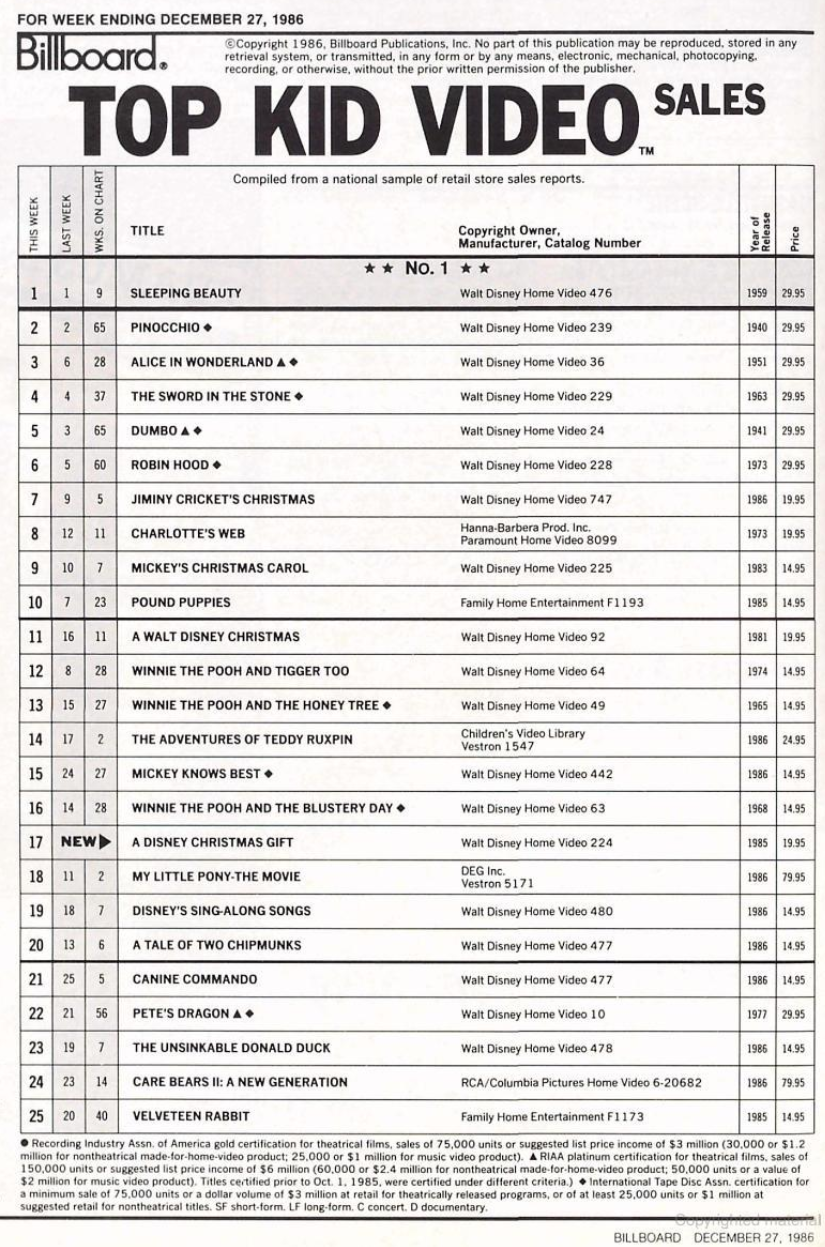
Developed by Karl Geurs, The New Adventures of Winnie the Pooh premiered on The Disney Channel on Sunday, January 17, 1988 at 8:30 AM (instead of competing with the broadcast networks’ Saturday morning cartoons), and then moved to ABC that fall with a promotional push that even included advertising on adult live-action fare such as Moonlighting and thirtysomething. The following year, NBC canceled Gummi Bears while ABC picked them up. Disney combined the two bear shows into a single show called the Gummi Bears/Winnie the Pooh Hour. This arrangement lasted a year before Gummi Bears changed networks again and moved to first-run syndication when its last season became part of the first season of The Disney Afternoon. The last original episode aired on October 26, 1991, but reruns continued on ABC for about a decade, years after The Walt Disney Company actually bought the network and launched other cartoons as part of One Saturday Morning, although Pooh was never part of this arrangement. Many ABC affiliates aired the show either early in the morning or late in the afternoon. After its network reruns finally ended in 2001, it saw several more years of Disney Channel, Toon Disney, and Playhouse Disney reruns.
New Adventures
dropped the educational aspect of Welcome to Pooh Corner, and
the tone of the show, despite the occasional attempt to tug at the
heartstrings with episodes such as “Stripes,” in which Tigger loses his
stripes, and the Humanitas Award-winning “Find Her, Keep Her,” in which
Rabbit discovers a baby bird named Kessie and takes care of her until
she can fly away, was more like an animated comedy with stuffed animals.
There was still an attempt to encourage positive behavior traits such as
sharing, friendship, and working together to achieve a common goal. The
show did not go out of its way to throw in dated references, but it did
update the characters somewhat by mentioning TV and movies in episodes
such as “Pooh Oughta Be in Pictures” and “Sorry, Wrong Slusher.” While
the narrator did not appear, Christopher Robin did and had at this point
been fully Americanized with the voice of Tim Hoskins. His mother even
appeared as an occasional character, and much like the Narrator in the
original four featurettes or Nanny on Muppet Babies, her face is
never seen. Patricia Parris, also the voice of Kanga in this series,
does her voice. The show also brought back Gopher from the original
animated featurettes; however, Howard Morris, his original voice artist,
was unavailable, as he had just committed to doing the voice of Wade the
Duck on CBS’s Garfield and Friends. Michael Gough took over the
role.
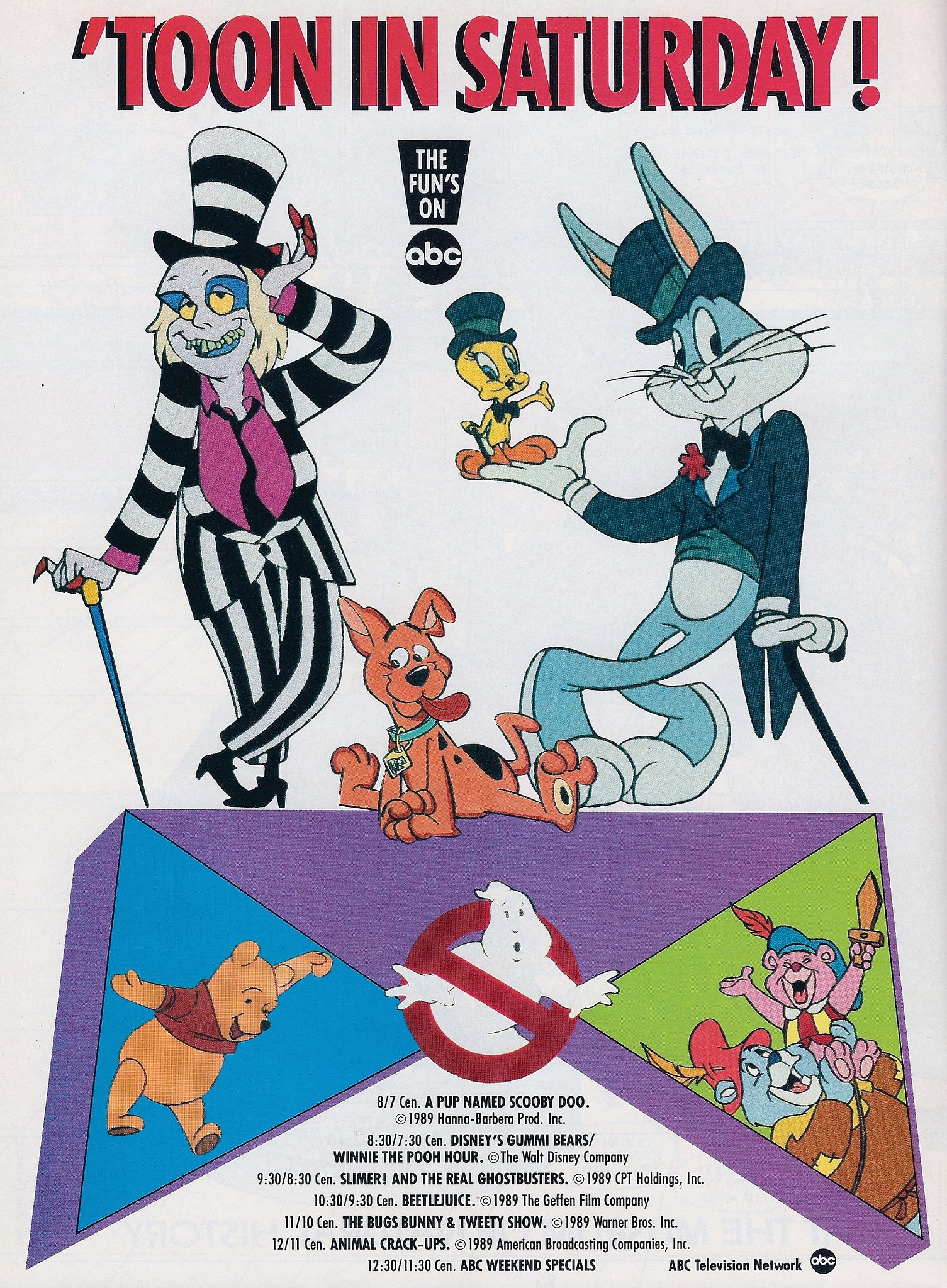
Unbearable fun: Between Pooh and The Gummi Bears, ABC came close to turning into the All-Bear Channel
When it came to the voice cast, Hal Smith retired as the voice of Pooh but continued to play Owl. Jim Cummings took over the role of Pooh, which he holds to this day in various Disney films, TV shows, and products, while Ken Sansom was now the voice of Rabbit. John Fiedler returned to the role of Piglet while Paul Winchell came back to play Tigger for the first two seasons until his health and schedule made it necessary for Jim Cummings to take that role over as well. Rounding out the cast was Peter Cullen as Eeyore and Nicholas Melody as Roo.
This
was the first Disney Pooh project the Sherman brothers were not
involved with; they would not be invited back until The Tigger
Movie in 2000. Walt Disney Television hired Steve Nelson, who
co-wrote the theme song to Webster, the last successful TV show
Paramount launched when Michael Eisner worked there, along with Thom
Sharp to compose a new theme song, a full orchestral score (as opposed
to the small band Welcome to Pooh Corner had), and a handful of
other songs for the show. Nelson and
Sharp also wrote the theme music and score for Darkwing Duck.
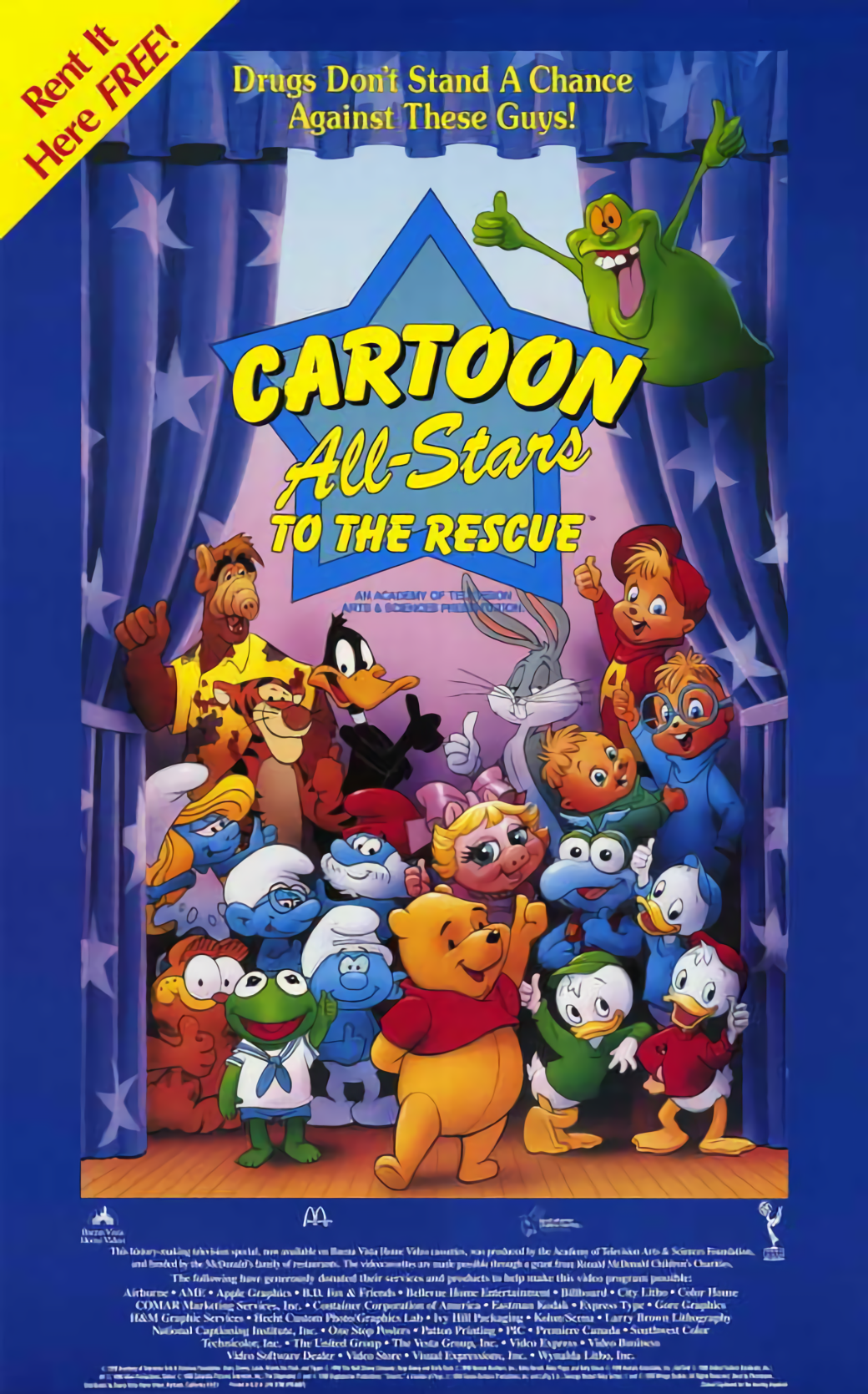
Much like Welcome to Pooh Corner, the show was made away from the Walt Disney Studios in Burbank; this time, the Academy of Television Arts and Sciences Complex housed a team of about 30 people who worked on writing, storyboarding, sound recording, character design and color as they outsourced everything else to either Japan, Taiwan, or England. Later seasons were animated in Australia where Walt Disney Television Animation had acquired the former Southern Star/Hanna-Barbera studio that brought The Berenstain Bears to CBS in 1985. Other animation was completed in the Philippines. This was not the first time Disney had outsourced the animation of Pooh beyond Burbank; Winnie the Pooh and a Day for Eeyore had been produced by Rick Reinert’s studio when the Disney artists were too busy on Mickey’s Christmas Carol or The Black Cauldron concurrently. Here, the animators drew inspiration not only from the original A.A. Milne stories, but the classic Disney short cartoons of the 1940s. The crew even had a son of one of the Nine Old Men on it: John Kimball, son of Ward Kimball. Believe it or not, it was another Ward of animation fame who almost got his hands on the rights to the characters: Jay Ward. The Rocky & Bullwinkle creator wanted to make a TV cartoon of the characters as early as 1957, but he could not make a deal to get permission to actually bring it to fruition.
This
iteration of Pooh also took a stand on a controversial social issue:
drugs. In 1990, several major animation studios lent their characters to
Cartoon All-Stars to the Rescue, a special that aired on multiple
broadcast and cable networks simultaneously. Pooh and Tigger appeared
alongside fellow Disney characters Huey, Dewey, and Louie and future
Disney acquisitions Baby Kermit, Baby Piggy, and Baby Gonzo.
Coincidentally, in 1989, Pooh won the Daytime Emmy for
Outstanding Animated Program, its first of two,
over both Muppet Babies and DuckTales.
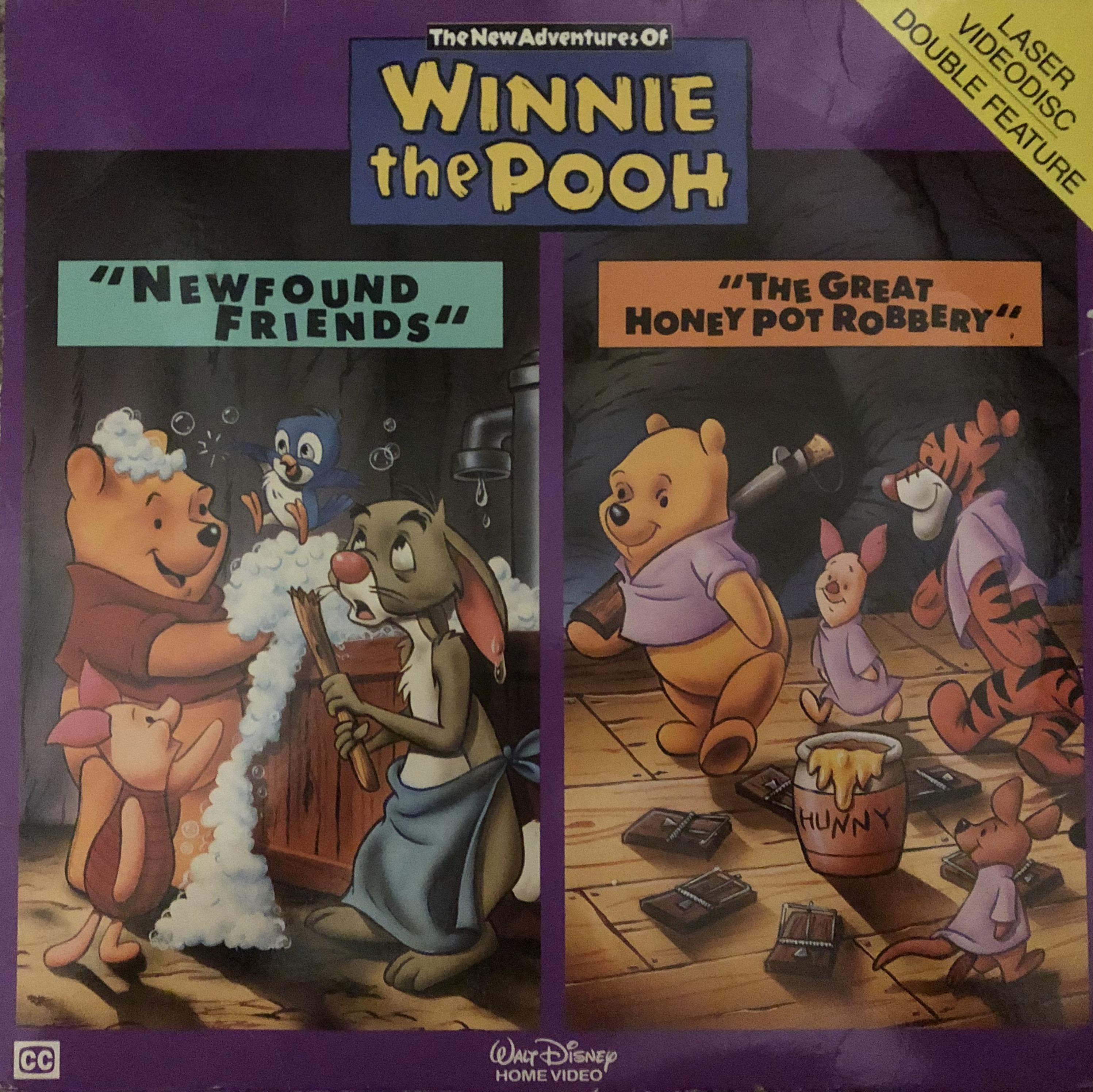
Over the show’s four seasons, 50 half-hour shows with 82 individual segments were produced. The show received several releases on VHS and laserdisc during the 1990s that sold very well, but only a limited selection of episodes made it to DVD and mainly outside the United States. The entire series was remastered in HD (but very awkwardly cropped for a 16x9 aspect ratio) and that remastered version is now on Disney+. It is unknown whether a 4x3 HD remastered version will ever surface.
After the show ended, the same crew produced the 1991 special Winnie the Pooh and Christmas Too, while many more animated specials and movies appeared over the years to come. However, despite new technological innovations such as computer animation and even more advanced Bunraku-style puppetry, Disney shifted their focus towards the youngest members of the audience in most of what they have done with the characters since the 1980s, with the possible exception of the 2011 animated theatrical release Winnie the Pooh and the 2018 live-action/CGI hybrid Christopher Robin. But these are all testaments to the timelessness of the characters A.A. Milne created and the indelible vision of Walt Disney who first brought them to the silver screen.
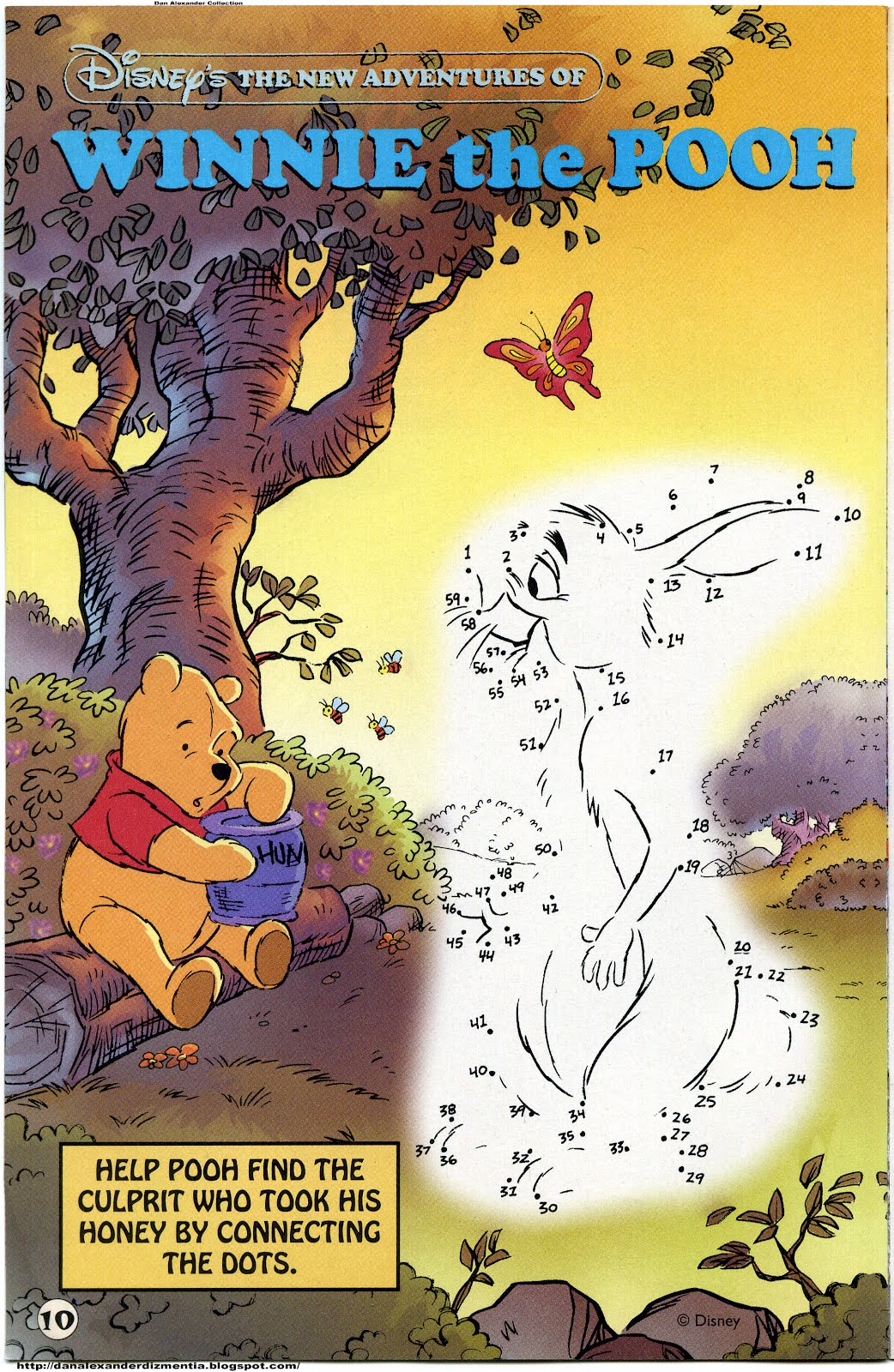
A
late 1990s promotional connect-the-dots era from the One Saturday
Morning years after Disney bought ABC (courtesy of Dan
Alexander's Dizmentia
blog)